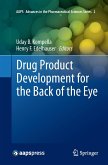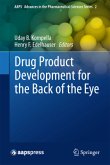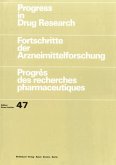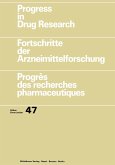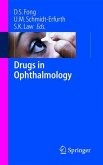Pharmacology of the Eye
Herausgegeben:Sears, M.L.;Mitarbeit:Chader, G.J.
Pharmacology of the Eye
Herausgegeben:Sears, M.L.;Mitarbeit:Chader, G.J.
- Broschiertes Buch
- Merkliste
- Auf die Merkliste
- Bewerten Bewerten
- Teilen
- Produkt teilen
- Produkterinnerung
- Produkterinnerung
Roots of the theory and practice of ocular pharmacology may be traced to the ancient Mesopotamian code of Hammurabi and then to several papyri reflecting the clinical interests of the Egyptians. The evolution of its art and science was irregularly paced until the nineteenth century when Kohler, in 1884, proved the anesthetic effect of cocaine on the cornea, and when Fraser, Laquer, Schmiedeberg, Meyer, and others studied the pharmacology of the autonomic nervous system by way of observations of the pupil. Advances in the past few decades have been nothing short of explosive. How can the…mehr
Andere Kunden interessierten sich auch für
![Drug Product Development for the Back of the Eye Drug Product Development for the Back of the Eye]() Drug Product Development for the Back of the Eye149,99 €
Drug Product Development for the Back of the Eye149,99 €![Drug Product Development for the Back of the Eye Drug Product Development for the Back of the Eye]() Drug Product Development for the Back of the Eye150,99 €
Drug Product Development for the Back of the Eye150,99 €![Drugs and Poisons in Humans Drugs and Poisons in Humans]() Osamu Suzuki / Kanako Watanabe (eds.)Drugs and Poisons in Humans231,99 €
Osamu Suzuki / Kanako Watanabe (eds.)Drugs and Poisons in Humans231,99 €![The Target Organ and the Toxic Process The Target Organ and the Toxic Process]() The Target Organ and the Toxic Process77,99 €
The Target Organ and the Toxic Process77,99 €![Progress in Drug Research / Fortschritte der Arzneimittelforschung / Progrès des recherches pharmaceutiques Progress in Drug Research / Fortschritte der Arzneimittelforschung / Progrès des recherches pharmaceutiques]() Progress in Drug Research / Fortschritte der Arzneimittelforschung / Progrès des recherches pharmaceutiques39,99 €
Progress in Drug Research / Fortschritte der Arzneimittelforschung / Progrès des recherches pharmaceutiques39,99 €![Progress in Drug Research / Fortschritte der Arzneimittelforschung / Progrès des recherches pharmaceutiques Progress in Drug Research / Fortschritte der Arzneimittelforschung / Progrès des recherches pharmaceutiques]() JuckerProgress in Drug Research / Fortschritte der Arzneimittelforschung / Progrès des recherches pharmaceutiques39,99 €
JuckerProgress in Drug Research / Fortschritte der Arzneimittelforschung / Progrès des recherches pharmaceutiques39,99 €![Drugs in Ophthalmology Drugs in Ophthalmology]() Donald S. Fong / Simon K Law / Ursula M. Schmidt-Erfurth (eds.)Drugs in Ophthalmology38,99 €
Donald S. Fong / Simon K Law / Ursula M. Schmidt-Erfurth (eds.)Drugs in Ophthalmology38,99 €-
-
-
Roots of the theory and practice of ocular pharmacology may be traced to the ancient Mesopotamian code of Hammurabi and then to several papyri reflecting the clinical interests of the Egyptians. The evolution of its art and science was irregularly paced until the nineteenth century when Kohler, in 1884, proved the anesthetic effect of cocaine on the cornea, and when Fraser, Laquer, Schmiedeberg, Meyer, and others studied the pharmacology of the autonomic nervous system by way of observations of the pupil. Advances in the past few decades have been nothing short of explosive. How can the student, physician, or basic research scientist stay in touch with these electrifying studies? To help with the answer to this question, the authors set as their goal the development of increased understanding so that the student, research scientist, and ophthalmologist can cope with the latest discoveries. The authors want to narrow what appears to be an ever-increasing gap between basic science and ophthalmology. The basic aspects of pharmacology have been presented in light of the natural physiology. In this regard, while distinctions among endogenous mechanisms, drug effects, and the pathogenesis of disease are to be separately recognized, appreciation must be given to the concept that both the desirable and unwanted manifestations or functions caused by either disease or drugs must very often represent a quantitative change in normal metabolic pathways.
Hinweis: Dieser Artikel kann nur an eine deutsche Lieferadresse ausgeliefert werden.
Hinweis: Dieser Artikel kann nur an eine deutsche Lieferadresse ausgeliefert werden.
Produktdetails
- Produktdetails
- Handbook of Experimental Pharmacology 69
- Verlag: Springer / Springer Berlin Heidelberg / Springer, Berlin
- Softcover reprint of the original 1st ed. 1984
- Seitenzahl: 768
- Erscheinungstermin: 29. Dezember 2011
- Englisch
- Abmessung: 244mm x 170mm x 41mm
- Gewicht: 1299g
- ISBN-13: 9783642692246
- ISBN-10: 3642692249
- Artikelnr.: 36120620
- Herstellerkennzeichnung
- Springer-Verlag GmbH
- Tiergartenstr. 17
- 69121 Heidelberg
- ProductSafety@springernature.com
- Handbook of Experimental Pharmacology 69
- Verlag: Springer / Springer Berlin Heidelberg / Springer, Berlin
- Softcover reprint of the original 1st ed. 1984
- Seitenzahl: 768
- Erscheinungstermin: 29. Dezember 2011
- Englisch
- Abmessung: 244mm x 170mm x 41mm
- Gewicht: 1299g
- ISBN-13: 9783642692246
- ISBN-10: 3642692249
- Artikelnr.: 36120620
- Herstellerkennzeichnung
- Springer-Verlag GmbH
- Tiergartenstr. 17
- 69121 Heidelberg
- ProductSafety@springernature.com
1 The History of Ophthalmic Therapeutics With 7 Figures.- References.- 2 Ocular Pharmacokinetics With 20 Figures.- Abbreviations.- A. Introduction.- I. Objectives.- II. Compartments and Barriers.- III. Routes of Administration and Penetration.- 1. Topical Administration.- 2. Local Injection.- 3. Systemic Administration.- IV. Animal Models and Human Experimentation.- 1. Animal Models.- 2. Human Experiments.- B. Topical Administration.- I. Factors Involved in Intraocular Penetration.- 1. The Tears and Contact with Ocular Surface.- 2. Corneal Penetration.- 3. Conjunctiva and Sclera.- 4. Intraocular Structures.- 5. Metabolism of Drugs During Intraocular Penetration.- II. Compartmental Analysis.- 1. Compartmentation.- 2. Two-Compartment Model.- 3. Tear Patterns.- 4. Other Compartments.- 5. Kinetics of Ocular Responses to Drugs.- 6. Parameter Determination.- III. Conclusions and Recommendations.- C. Local Injections.- I. Subconjunctival.- 1. Regurgitation.- 2. Depot Dynamics.- 3. Aqueous Humor Concentration.- 4. Entry Pathways.- 5. Vitreous Penetration.- 6. Retrobulbar Injection.- II. Intravitreal Injection.- 1. Diffusion in Vitreous.- 2. Loss from the Vitreous Chamber.- 3. Drug Kinetics.- 4. Application to Humans.- D. Systemic Administration.- I. Intraocular Drug Penetration.- 1. Structures Related to Entry from Blood.- 2. The Blood-Vitreous Barrier.- 3. Chemical Factors in Drug Penetration.- 4. Drug Distribution in the Eye.- II. Compartmental Analysis.- 1. Formulation of Aqueous Humor Dynamics.- 2. One-Compartment Approximation.- 3. Changes in Aqueous Concentration.- 4. Kinetics of Intracameral Penetration.- 5. Penetration into the Vitreous.- 6. Penetration into the Cornea and Lens.- III. Conclusions and Recommendations.- E. Kinetics in Ocular Disease.- I. Inflammation andits Models.- II. Effects on Ocular Parameters.- 1. Permeability.- 2. Active Transport.- 3. Vasomotor Effects.- III. Effects on Drug Kinetics.- 1. Topical Application.- 2. Systemic Penetration.- 3. Periocular Injection.- 4. Intravitreal Injection.- F. Conclusion.- References.- 3 Biotransformation and Drug Metabolism With 25 Figures.- A. Introduction.- B. Hepatic Drug-Metabolizing Systems.- I. Microsomal Electron Transport Systems (Phase I Enzymes).- 1. Cytochrome P-450.- 2. NADPH · Cytochrome P-450 Reductase.- 3. Cytochrome b5 and NADH · Cytochrome b5 Reductase.- II. Reactions Catalyzed by the Cytochrome P-450 System.- 1. Oxidative Reactions.- 2. Reductive Reactions.- III. Conjugation Reactions (Phase II Reactions).- 1. Glucuronidation.- 2. Sulfation.- 3. Acetylation.- 4. Conjugation with Amino Acids.- 5. Methylation.- 6. Conjugation with Glutathione.- IV. Induction of Drug-Metabolizing Enzymes.- C. Ocular Drug Metabolism.- I. Aryl Hydrocarbon Hydroxylase Induction in the Eye.- II. Tissue Distribution of Drug-Metabolizing Enzymes in the Eye.- III. Drug Toxicity - An Experimental Approach.- D. Concluding Remarks.- References.- 4 Cholinergics With 11 Figures.- A. Chemistry Related to Biological Activity.- I. Cholinergic Neurotransmission.- II. Direct-Acting Agonists.- 1. Muscarinic Agents.- 2. Nicotinic Agents.- III. Indirect-Acting Agonists: Anticholinesterases.- 1. Carbamates.- 2. Organophosphorous Compounds.- B. Ocular Anatomy/Physiology Relevant to Cholinergic Mechanisms: Acute Effects of Cholinergic Drugs.- I. Lacrimation.- II. Cornea.- III. Lens.- IV. Pupillary Movement and Accommodation.- V. Aqueous Humor Formation, Removal, and Composition; Blood-Aqueous Barrier.- 1. Basic Anatomy and Physiology.- 2. Acute Effects of Cholinergic Drugs.- VI. Retina.- VII.Oculorotary and Respiratory Skeletal Muscles.- C. Longer-Term Effects of Cholinergic Drugs or Altered Cholinergic Neurotransmission.- I. Cholinergic Sensitivity in Ocular Smooth Muscles.- 1. Physiologically and Pharmacologically Induced Alterations.- 2. Disease-Induced Alterations.- 3. Surgically Induced Alterations.- II. Cholinergic Toxicity.- 1. Lens (Cataractogenesis).- 2. Iris/Ciliary Muscle/Trabecular Meshwork.- References.- 5 a Autonomic Nervous System: Adrenergic Agonists With 21 Figures.- A. Introduction.- B. Cellular Sites and Mechanism of Adrenergic Action.- C. Modulation and Interaction of Receptor Types.- D. Sensitivity.- E. Stereoisomerism.- F. Storage, Release, and Degradation.- I. Monoamine Oxidase.- II. Catechol-O-methyltransferase.- G. Pharmacokinetics.- I. Penetration.- II. Distribution and Accumulation.- III. Duration.- IV. Action of Drugs on Intraocular Pressure.- H. Tissue Functions.- I. Lacrimal Gland.- II. Cornea and Lens.- III. Iris.- J. Blood Flow.- K. Intraocular Pressure.- L. Other Interactions.- I. Guanyl Cyclase.- II. Steroids and Adrenergics.- III. Adrenergics and Prostaglandins.- IV. Adrenergics and Ocular Pigment.- M. Retina.- References.- 5b Autonomic Nervous System: Adrenergic Antagonists.- A. Introduction.- B. Beta-Adrenergic Antagonists.- I. Animal Pharmacology.- 1. Intraocular Pressure.- 2. Aqueous Humor Dynamics.- 3. Interactions with Beta-Adrenergic Receptors in the Eye.- 4. Mechanisms of Action on Intraocular Pressure.- 5. Ocular Penetration and Distribution.- 6. Other Ocular Pharmacology.- II. Clinical Pharmacology.- 1. Intraocular Pressure.- 2. Aqueous Humor Dynamics.- 3. Beta-Adrenergic Receptor Blockade in the Eye.- 4. Mechanisms of Action.- 5. Ocular Penetration.- C. Alpha-Adrenergic Antagonists.- I. Animal Pharmacology.- 1.Selective Alpha-Adrenergic Antagonists.- 2. Alpha- and Beta-Adrenergic Antagonists (Labetalol).- II. Clinical Pharmacology.- References.- 6 Carbonic Anhydrase: Pharmacology of Inhibitors and Treatment of Glaucoma With 10 Figures.- A. History.- B. Pharmacology of the Clinically Used Carbonic Anhydrase Inhibitors..- C. Physiology of Ocular Carbonic Anhydrase Inhibition.- I. Aqueous Humor Dynamics.- II. Aqueous Flow.- III. Relation to Pressure.- IV. Chemical Mechanisms of Flow.- V. Relation to Systemic Effects.- VI. Pharmacology of the Inhibitors Related to Ocular Effect and Enzyme Inhibition.- D. Clinical Uses of Carbonic Anhydrase Inhibitors.- I. Glaucoma.- II. Miscellaneous Uses and Effects.- E. Urolithiasis with Carbonic Anhydrase Inhibitors.- F. Other Toxic Effects.- G. Summary.- References.- 7 Autacoids and Neuropeptides With 5 Figures.- A. Introduction.- B. Prostaglandins, Prostacyclin, Thromboxane, and Lipoxygenase Products.- I. General Background.- II. Occurrence and Biosynthesis in the Eye.- III. Elimination.- IV. Effects in the Eye.- 1. Blood Flow.- 2. Blood-Aqueous Barrier and Formation of Aqueous Humor.- 3. Intraocular Pressure.- 4. Outflow of Aqueous Humor.- 5. Iridial and Ciliary Smooth Muscles.- 6. Miscellaneous Effects.- V. Interaction with the Autonomic and Sensory Nervous Systems in the Eye.- VI. Pathophysiological Considerations.- 1. Immediate Response to Injury of the Eye.- 2. Inflammation of the Eye.- 3. Other Disorders in the Eye Possibly Involving Prostaglandins.- C. Histamine.- I. General Background.- II. Occurrence and Effects in the Eye.- III. Pathophysiological Considerations.- D. 5-Hydroxytryptamine.- I. General Background.- II. Occurrence and Effects in the Eye.- E. Plasma Kinins.- I. General Background.- II. Effects in the Eye.- F. The Renin-Angiotensin System.- I. General Background.- II. Occurrence in the Eye.- G. Substance P.- I. General Background.- II. Distribution in the Eye.- III. Effects in the Eye.- 1. Retina.- 2. Iridial Smooth Muscles.- 3. Ocular Circulation and Blood-Aqueous Barrier.- 4. Intraocular Pressure.- 5. Formation and Outflow of Aqueous Humor.- H. Enkephalins.- I. General Background.- II. Occurrence and Effects in the Eye.- J. Neurotensin.- K. Hypothalamic Peptides Regulating the Adenohypophysis.- I. Somatostatin.- II. Thyrotropin-Releasing Hormone.- III. Luteinizing-Hormone-Releasing Hormone.- L. Peptide Hormones Secreted by the Neurohypophysis.- I. General Background.- II. Effects of Antidiuretic Hormone in the Eye.- III. Effects of Oxytocin in the Eye.- M. Melanocyte-Stimulating Hormones.- I. Effects in the Eye.- N. Vasoactive Intestinal Polypeptide.- I. General Background.- II. Localization and Effects in the Eye.- O. Glucagon.- P. Gastrin/Cholecystokinin.- Q. Summary.- References.- 8 Vitamin A With 6 Figures.- A. Introduction.- B. Retinoid Structure.- C. Retinoid Properties.- D. Retinoid Identification.- I. Spectral Methods.- II. Fluorescence Methods.- III. Colorimetric Methods.- IV. High-Pressure Liquid Chromatography.- E. Retinoid Metabolism.- F. Retinoid Uptake.- G. Retinoid Action.- I. The Visual Process.- II. Glycoprotein Biosynthesis.- III. Hormone-like Action.- References.- 9 Anti-Infective Agents.- A. Introduction.- B. Accurate Diagnosis and Drug Choice.- I. Mechanisms of Action.- II. Penetration and Absorption.- 1. Protein and Tissue Binding.- 2. The Blood-Aqueous Barrier.- 3. Physicochemical Influences.- 4. Aqueous and Uveoscleral Outflow.- III. Limiting Factors.- 1. Age.- 2. Renal Disease.- 3. Liver Disease.- 4. Enzymes.- 5. Pregnancy.- 6. Ocular Damage and Disease.-IV. Routes of Administration.- 1. Topically Applied Antibiotic Drops.- 2. Continuous Corneal Lavage with Antibiotic Solutions.- 3. Subconjunctival Injections of Antibiotics.- V. Use of Antibiotics in Combination.- 1. Prevention of Emergence of Drug-Resistant Mutants.- 2. Treatment of Mixed Infections.- 3. Initial Treatment of Vision-Threatening Infections.- 4. Antibiotic Synergism and Antagonism.- VI. Adverse Drug Interactions.- C. Postoperative Intraocular Infections (Endophthalmitis).- I. Incidence.- II. Results of Therapy.- III. Contributory Factors.- 1. Sources of Infection in the Surgical Environment.- 2. Ophthalmic Operative Area.- 3. Influence of Host Tissue.- 4. Organisms Responsible for Intraocular Infection.- IV. Antibiotic Prophylaxis.- V. Use of Steroids.- VI. Vitrectomy.- D. Antibiotics.- I. Penicillin Derivatives.- 1. Ampicillin.- 2. Amoxicillin.- 3. Carbenicillin.- 4. Ticarcillin.- II. Probenecid.- III. Cephalosporins.- IV. Aminoglycosides.- 1. Streptomycin and Dihydrostreptomycin.- 2. Gentamicin.- 3. Tobramycin.- 4. Neomycin.- 5. Kanamycin.- 6. Amikacin.- 7. Spectinomycin.- 8. Others.- V. Erythromycin.- VI. Lincomycin.- VII. Clindamycin.- VIII. Oleandomycin.- IX. Carbomycin.- X. Spiramycin.- XI. Novobiocin.- XII. Ristocetin.- XIII. Vancomycin.- XIV. Bacitracin.- XV. Polymyxin B.- XVI. Soframycin.- XVII. Colistin.- XVIII. Sulfonamides.- XIX. Trimethoprim-Sulfamethoxazole.- XX. Chloramphenicol.- 1. Penetration and Absorption.- 2. Toxicity and Side Effects.- XXI. Tetracyclines.- 1. Penetration and Absorption.- 2. Fluorescence.- 3. Toxicity and Side Effects.- XXII. Pyrimethamine.- 1. Value.- 2. Toxicity.- 3. Penetration and Dosage.- XXIII. Drugs Used in the Treatment of Fungal Infections.- 1. Griseofulvin, Nystatin, and Amphotericin B.- 2. 5-Fluorocytosine.- 3. Imidazoles.- XXIV. Diethylcarbamazine in the Treatment of Onchocerciasis.- References.- 10a Anti-Inflammatory Agents: Steroids as Anti-Inflammatory Agents With 18 Figures.- A. Introduction.- B. Historical Development.- I. Cortisone.- II. Use of Steroids in Ophthalmology.- C. Steroid Therapy.- I. Activity of Steroid Compounds.- 1. Potency.- 2. Absorption and Distribution.- 3. Metabolism.- II. Routes of Administration.- 1. Topical.- 2. Periocular.- 3. Systemic.- 4. Intravitreal.- III. Therapeutic Approaches.- 1. Specific Clinical Problems and Controversies.- 2. Current Assessment.- IV. Complications.- 1. Glaucoma.- 2. Cataract.- 3. Other Ocular Effects.- 4. Systemic Complications.- D. Cellular and Molecular Mechanisms.- I. The Immune System.- 1. Leukocyte Kinetics and Function.- 2. Vascular and Inflammatory Effects.- 3. Ocular Immune Mechanisms.- II. The Glucocorticoid Receptor.- 1. The Target Cell.- 2. Cellular Sensitivity and Modulation of Steroid Responses.- 3. Permissive Effects and Hormonal Interactions.- 4. Glucocorticoid Receptors in Ocular Tissues.- 5. Implications.- References.- 10b Anti-Inflammatory Agents: Nonsteroidal Anti-Inflammatory Drugs With 4 Figures.- A. Introduction.- B. Mechanism of Action of Nonsteroidal Anti-Inflammatory Drugs.- C. Salicylates.- D. Indomethacin.- E. Pyrazolon Derivatives.- F. Propionic Acid Derivatives.- G. Anthranilic Acid Derivatives.- References.- 11 Chemotherapy of Ocular Viral Infections and Tumors With 6 Figures.- A. Introduction.- B. Clinically Available Antiviral Agents.- I. 5-Iodo-2?-deoxyuridine (Idoxuridine).- 1. Synthesis.- 2. Antiviral Activity.- 3. Effects on Normal Cells.- 4. Mechanism of Action.- II. 9-?-D-Arabinofuranosyladenine (Adenine, Arabinoside, Vidarabine).- 1. Synthesis.- 2. Antiviral Activity.- 3.Effects on Normal Cells.- 4. Mechanism of Action.- III. 5-Trifluoromethyl-2?-deoxyuridine (Trifluorothymidine, Viroptic, Trifluridine).- 1. Synthesis.- 2. Antiviral Activity.- 3. Effects on Normal Cells.- 4. Mechanism of Action.- C. Newer Agents Under Development.- I. 9-(2-Hydroxyethoxymethyl)guanine (Acyclovir, Acycloguanosine).- 1. Synthesis.- 2. Antiviral Activity.- 3. Effects on Normal Cells.- 4. Mechanism of Action.- II. 5-Ethyl-2?-deoxyuridine (Aedurid).- 1. Synthesis.- 2. Antiviral Activity.- 3. Effects on Normal Cells.- 4. Mechanism of Action.- III. E-5-(2-Bromovinyl)-2?-deoxyuridine.- IV. l-(2-Deoxy-2-fluoro-?-D-arabinosyl)-5-iodo-cytosine.- V. 5-Iodo-5?-amino-2?,5?-dideoxyuridine.- 1. Synthesis.- 2. Antiviral Activity.- 3. Effects on Normal Cells.- 4. Mechanism of Action.- VI. Phosphonoacetate and Phosphonoformate (Foscarnet).- 1. Synthesis.- 2. Antiviral Activity.- 3. Effects on Normal Cells.- 4. Mechanism of Action.- References.- 12 Immunosuppressive Drugs With 8 Figures.- A. Introduction.- B. Alkylating Agents.- I. Chemical Structure and Metabolism.- II. Mode of Action.- III. Effects on the Immune System.- C. Antimetabolic Drugs.- I. Purine Analogs.- 1. Mode of Action.- 2. Effects on the Immune System.- II. Pyrimidine Analogs.- 1. Mode of Action.- 2. Effects on the Immune System.- III. Folic Acid Analogs.- 1. Mode of Action.- 2. Effects on the Immune System.- D. Cyclosporin A.- I. Mode of Action.- II. Effects on the Immune System.- E. Antilymphocyte Sera.- I. Preparations.- II. Mode of Action.- III. Effects on the Immune System.- IV. Adverse Side Effects.- F. Ionizing Irradiation.- G. Immunosuppressive Agents of Potential Future Use.- H. Immunosuppressive Agents in Ocular Conditions.- I. Cyclophosphamide.- II. Chlorambucil.- III.Azathioprine.- IV. Methotrexate.- V. Cyclosporin A.- VI. Antilymphocyte Sera.- VII. Adverse Side Effects.- References.- 13 Anticoagulants, Fibrinolytics, and Hemostatics With 3 Figures.- A. Introduction: The Hemostatic Mechanism.- B. Anticoagulants.- I. Direct Anticoagulants (Heparin).- II. Indirect Anticoagulants.- III. Contraindications: Precautions in Ophthalmology.- C. Fibrinolytics.- I. Commonly Used Fibrinolytic Agents.- 1. Streptokinase.- 2. Urokinase.- 3. Plasmin.- II. Therapeutic Thrombolysis: Effect on Hemostasis.- III. Fibrinolytics in Ophthalmology.- 1. Occlusion of the Central Retinal Vein.- 2. Hemorrhages in the Anterior Chamber and Vitreous Body.- D. Hemostatics.- I. Specific.- 1. Substitution Therapy.- 2. Antifibrinolytics.- II. Nonspecific.- References.- 14 Oxygen.- A. Introduction.- B. Oxygen and the Adult Eye.- C. Oxygen and the Immature Eye.- I. Retrolental Fibroplasia.- II. Monitoring Oxygen Administration in the Nursery.- D. Oxygen Interaction with Other Drugs.- I. Anti-Inflammatory Agents.- II. Antioxidants in Retrolental Fibroplasia.- 1. ?-Tocopherol.- 2. Superoxide Dismutase.- 3. Other Antioxidants.- E. Conclusions.- References.- 15 The Alipathic Alcohols.- A. General.- B. Ocular Effects of Single Doses of Ethanol in Nonhabituated Individuals.- I. Muscle Balance.- II. Extraocular Muscles in Action.- III. Nystagmus.- IV. Intraocular Muscles.- 1. The Iris.- 2. Accommodation.- V. Electrophysiological Measurements.- VI. Miscellaneous Measurements of Visual Function.- VII. Intraocular Pressure.- C. The Special Case of Disulfiram (Antabuse).- D. Chronic Alcoholism and the Eye.- E. Methanol.- References.- 16 Photosensitizing Substances With 1 Figure.- A. Direct Action of Ultraviolet Light on Skin.- I. Mechanism of Ultraviolet Action.- II. DirectAction of Light on the Eye.- B. Photosensitization.- I. Mechanism.- II. Ocular Effects.- C. Photosensitizing Substances.- I. Exogenous Photosensitizers.- II. Endogenous Photosensitizers.- D. Conclusions.- References.- 17 Trace Elements in the Eye With 1 Figure.- A. Introduction.- B. Iron.- C. Zinc.- D. Copper.- E. Selenium.- F. Vanadium.- G. Chromium.- H. Conclusion.- References.- 18 Clinical Trials.- A. A Strategy of Research.- B. Planning the Trial.- I. Defining the Research Goals.- II. Sample Size.- III. The Ethical Basis.- C. Conducting the Trial.- I. Bias.- II. Data Monitoring.- III. Follow-up.- D. Analysis of the Results.- I. Adherence.- II. Eyes Come in Twos.- III. Variable Duration of Follow-up.- IV. Tests of Significance and Data Analysis.- E. A Greater Awareness.- References.- 19a Diagnostic Agents in Ophthalmology: Sodium Fluorescein and Other Dyes With 1 Figure.- A. Sodium Fluorescein.- I. Introduction.- II. Defects of the Corneal and Conjunctival Epithelia.- III. Use for Applanation Tonometry.- IV. Fitting of Contact Lenses.- V. Assessment of the Lacrimal System.- VI. The Seidel Test - Documentation of Appearance of Aqueous Humor in the Cul-de-Sac.- VII. Measurement of the Rate of Aqueous Humor Formation.- VIII. Measurement of Arm-Retina Circulation Times and Retinal Transit Times.- IX. Fundus and Iris Fluorescein Angiography.- X. Assessment of the Blood-Ocular Barriers.- 1. Aqueous Fluorophotometry.- 2. Vitreous Fluorophotometry.- 3. Histopathology.- B. Rose Bengal.- C. Indocyanine Green.- D. Other Dyes for Retinal and Choroidal Angiography.- E. Other Dyes for Vital Staining of the Conjunctiva and Cornea.- References.- 19b Diagnostic Agents in Ophthalmology: Drugs and the Pupil.- A. Introduction.- B. The Sympathetic Nervous System.- I. Epinephrine.-II. Cocaine.- III. Hydroxy amphetamine.- C. The Parasympathetic Nervous System.- D. Distinction Between Pharmacologic Blockade and Oculomotor Nerve Palsy.- E. Diagnosis of Accommodative Esotropia.- References.
1 The History of Ophthalmic Therapeutics With 7 Figures.- References.- 2 Ocular Pharmacokinetics With 20 Figures.- Abbreviations.- A. Introduction.- I. Objectives.- II. Compartments and Barriers.- III. Routes of Administration and Penetration.- 1. Topical Administration.- 2. Local Injection.- 3. Systemic Administration.- IV. Animal Models and Human Experimentation.- 1. Animal Models.- 2. Human Experiments.- B. Topical Administration.- I. Factors Involved in Intraocular Penetration.- 1. The Tears and Contact with Ocular Surface.- 2. Corneal Penetration.- 3. Conjunctiva and Sclera.- 4. Intraocular Structures.- 5. Metabolism of Drugs During Intraocular Penetration.- II. Compartmental Analysis.- 1. Compartmentation.- 2. Two-Compartment Model.- 3. Tear Patterns.- 4. Other Compartments.- 5. Kinetics of Ocular Responses to Drugs.- 6. Parameter Determination.- III. Conclusions and Recommendations.- C. Local Injections.- I. Subconjunctival.- 1. Regurgitation.- 2. Depot Dynamics.- 3. Aqueous Humor Concentration.- 4. Entry Pathways.- 5. Vitreous Penetration.- 6. Retrobulbar Injection.- II. Intravitreal Injection.- 1. Diffusion in Vitreous.- 2. Loss from the Vitreous Chamber.- 3. Drug Kinetics.- 4. Application to Humans.- D. Systemic Administration.- I. Intraocular Drug Penetration.- 1. Structures Related to Entry from Blood.- 2. The Blood-Vitreous Barrier.- 3. Chemical Factors in Drug Penetration.- 4. Drug Distribution in the Eye.- II. Compartmental Analysis.- 1. Formulation of Aqueous Humor Dynamics.- 2. One-Compartment Approximation.- 3. Changes in Aqueous Concentration.- 4. Kinetics of Intracameral Penetration.- 5. Penetration into the Vitreous.- 6. Penetration into the Cornea and Lens.- III. Conclusions and Recommendations.- E. Kinetics in Ocular Disease.- I. Inflammation andits Models.- II. Effects on Ocular Parameters.- 1. Permeability.- 2. Active Transport.- 3. Vasomotor Effects.- III. Effects on Drug Kinetics.- 1. Topical Application.- 2. Systemic Penetration.- 3. Periocular Injection.- 4. Intravitreal Injection.- F. Conclusion.- References.- 3 Biotransformation and Drug Metabolism With 25 Figures.- A. Introduction.- B. Hepatic Drug-Metabolizing Systems.- I. Microsomal Electron Transport Systems (Phase I Enzymes).- 1. Cytochrome P-450.- 2. NADPH · Cytochrome P-450 Reductase.- 3. Cytochrome b5 and NADH · Cytochrome b5 Reductase.- II. Reactions Catalyzed by the Cytochrome P-450 System.- 1. Oxidative Reactions.- 2. Reductive Reactions.- III. Conjugation Reactions (Phase II Reactions).- 1. Glucuronidation.- 2. Sulfation.- 3. Acetylation.- 4. Conjugation with Amino Acids.- 5. Methylation.- 6. Conjugation with Glutathione.- IV. Induction of Drug-Metabolizing Enzymes.- C. Ocular Drug Metabolism.- I. Aryl Hydrocarbon Hydroxylase Induction in the Eye.- II. Tissue Distribution of Drug-Metabolizing Enzymes in the Eye.- III. Drug Toxicity - An Experimental Approach.- D. Concluding Remarks.- References.- 4 Cholinergics With 11 Figures.- A. Chemistry Related to Biological Activity.- I. Cholinergic Neurotransmission.- II. Direct-Acting Agonists.- 1. Muscarinic Agents.- 2. Nicotinic Agents.- III. Indirect-Acting Agonists: Anticholinesterases.- 1. Carbamates.- 2. Organophosphorous Compounds.- B. Ocular Anatomy/Physiology Relevant to Cholinergic Mechanisms: Acute Effects of Cholinergic Drugs.- I. Lacrimation.- II. Cornea.- III. Lens.- IV. Pupillary Movement and Accommodation.- V. Aqueous Humor Formation, Removal, and Composition; Blood-Aqueous Barrier.- 1. Basic Anatomy and Physiology.- 2. Acute Effects of Cholinergic Drugs.- VI. Retina.- VII.Oculorotary and Respiratory Skeletal Muscles.- C. Longer-Term Effects of Cholinergic Drugs or Altered Cholinergic Neurotransmission.- I. Cholinergic Sensitivity in Ocular Smooth Muscles.- 1. Physiologically and Pharmacologically Induced Alterations.- 2. Disease-Induced Alterations.- 3. Surgically Induced Alterations.- II. Cholinergic Toxicity.- 1. Lens (Cataractogenesis).- 2. Iris/Ciliary Muscle/Trabecular Meshwork.- References.- 5 a Autonomic Nervous System: Adrenergic Agonists With 21 Figures.- A. Introduction.- B. Cellular Sites and Mechanism of Adrenergic Action.- C. Modulation and Interaction of Receptor Types.- D. Sensitivity.- E. Stereoisomerism.- F. Storage, Release, and Degradation.- I. Monoamine Oxidase.- II. Catechol-O-methyltransferase.- G. Pharmacokinetics.- I. Penetration.- II. Distribution and Accumulation.- III. Duration.- IV. Action of Drugs on Intraocular Pressure.- H. Tissue Functions.- I. Lacrimal Gland.- II. Cornea and Lens.- III. Iris.- J. Blood Flow.- K. Intraocular Pressure.- L. Other Interactions.- I. Guanyl Cyclase.- II. Steroids and Adrenergics.- III. Adrenergics and Prostaglandins.- IV. Adrenergics and Ocular Pigment.- M. Retina.- References.- 5b Autonomic Nervous System: Adrenergic Antagonists.- A. Introduction.- B. Beta-Adrenergic Antagonists.- I. Animal Pharmacology.- 1. Intraocular Pressure.- 2. Aqueous Humor Dynamics.- 3. Interactions with Beta-Adrenergic Receptors in the Eye.- 4. Mechanisms of Action on Intraocular Pressure.- 5. Ocular Penetration and Distribution.- 6. Other Ocular Pharmacology.- II. Clinical Pharmacology.- 1. Intraocular Pressure.- 2. Aqueous Humor Dynamics.- 3. Beta-Adrenergic Receptor Blockade in the Eye.- 4. Mechanisms of Action.- 5. Ocular Penetration.- C. Alpha-Adrenergic Antagonists.- I. Animal Pharmacology.- 1.Selective Alpha-Adrenergic Antagonists.- 2. Alpha- and Beta-Adrenergic Antagonists (Labetalol).- II. Clinical Pharmacology.- References.- 6 Carbonic Anhydrase: Pharmacology of Inhibitors and Treatment of Glaucoma With 10 Figures.- A. History.- B. Pharmacology of the Clinically Used Carbonic Anhydrase Inhibitors..- C. Physiology of Ocular Carbonic Anhydrase Inhibition.- I. Aqueous Humor Dynamics.- II. Aqueous Flow.- III. Relation to Pressure.- IV. Chemical Mechanisms of Flow.- V. Relation to Systemic Effects.- VI. Pharmacology of the Inhibitors Related to Ocular Effect and Enzyme Inhibition.- D. Clinical Uses of Carbonic Anhydrase Inhibitors.- I. Glaucoma.- II. Miscellaneous Uses and Effects.- E. Urolithiasis with Carbonic Anhydrase Inhibitors.- F. Other Toxic Effects.- G. Summary.- References.- 7 Autacoids and Neuropeptides With 5 Figures.- A. Introduction.- B. Prostaglandins, Prostacyclin, Thromboxane, and Lipoxygenase Products.- I. General Background.- II. Occurrence and Biosynthesis in the Eye.- III. Elimination.- IV. Effects in the Eye.- 1. Blood Flow.- 2. Blood-Aqueous Barrier and Formation of Aqueous Humor.- 3. Intraocular Pressure.- 4. Outflow of Aqueous Humor.- 5. Iridial and Ciliary Smooth Muscles.- 6. Miscellaneous Effects.- V. Interaction with the Autonomic and Sensory Nervous Systems in the Eye.- VI. Pathophysiological Considerations.- 1. Immediate Response to Injury of the Eye.- 2. Inflammation of the Eye.- 3. Other Disorders in the Eye Possibly Involving Prostaglandins.- C. Histamine.- I. General Background.- II. Occurrence and Effects in the Eye.- III. Pathophysiological Considerations.- D. 5-Hydroxytryptamine.- I. General Background.- II. Occurrence and Effects in the Eye.- E. Plasma Kinins.- I. General Background.- II. Effects in the Eye.- F. The Renin-Angiotensin System.- I. General Background.- II. Occurrence in the Eye.- G. Substance P.- I. General Background.- II. Distribution in the Eye.- III. Effects in the Eye.- 1. Retina.- 2. Iridial Smooth Muscles.- 3. Ocular Circulation and Blood-Aqueous Barrier.- 4. Intraocular Pressure.- 5. Formation and Outflow of Aqueous Humor.- H. Enkephalins.- I. General Background.- II. Occurrence and Effects in the Eye.- J. Neurotensin.- K. Hypothalamic Peptides Regulating the Adenohypophysis.- I. Somatostatin.- II. Thyrotropin-Releasing Hormone.- III. Luteinizing-Hormone-Releasing Hormone.- L. Peptide Hormones Secreted by the Neurohypophysis.- I. General Background.- II. Effects of Antidiuretic Hormone in the Eye.- III. Effects of Oxytocin in the Eye.- M. Melanocyte-Stimulating Hormones.- I. Effects in the Eye.- N. Vasoactive Intestinal Polypeptide.- I. General Background.- II. Localization and Effects in the Eye.- O. Glucagon.- P. Gastrin/Cholecystokinin.- Q. Summary.- References.- 8 Vitamin A With 6 Figures.- A. Introduction.- B. Retinoid Structure.- C. Retinoid Properties.- D. Retinoid Identification.- I. Spectral Methods.- II. Fluorescence Methods.- III. Colorimetric Methods.- IV. High-Pressure Liquid Chromatography.- E. Retinoid Metabolism.- F. Retinoid Uptake.- G. Retinoid Action.- I. The Visual Process.- II. Glycoprotein Biosynthesis.- III. Hormone-like Action.- References.- 9 Anti-Infective Agents.- A. Introduction.- B. Accurate Diagnosis and Drug Choice.- I. Mechanisms of Action.- II. Penetration and Absorption.- 1. Protein and Tissue Binding.- 2. The Blood-Aqueous Barrier.- 3. Physicochemical Influences.- 4. Aqueous and Uveoscleral Outflow.- III. Limiting Factors.- 1. Age.- 2. Renal Disease.- 3. Liver Disease.- 4. Enzymes.- 5. Pregnancy.- 6. Ocular Damage and Disease.-IV. Routes of Administration.- 1. Topically Applied Antibiotic Drops.- 2. Continuous Corneal Lavage with Antibiotic Solutions.- 3. Subconjunctival Injections of Antibiotics.- V. Use of Antibiotics in Combination.- 1. Prevention of Emergence of Drug-Resistant Mutants.- 2. Treatment of Mixed Infections.- 3. Initial Treatment of Vision-Threatening Infections.- 4. Antibiotic Synergism and Antagonism.- VI. Adverse Drug Interactions.- C. Postoperative Intraocular Infections (Endophthalmitis).- I. Incidence.- II. Results of Therapy.- III. Contributory Factors.- 1. Sources of Infection in the Surgical Environment.- 2. Ophthalmic Operative Area.- 3. Influence of Host Tissue.- 4. Organisms Responsible for Intraocular Infection.- IV. Antibiotic Prophylaxis.- V. Use of Steroids.- VI. Vitrectomy.- D. Antibiotics.- I. Penicillin Derivatives.- 1. Ampicillin.- 2. Amoxicillin.- 3. Carbenicillin.- 4. Ticarcillin.- II. Probenecid.- III. Cephalosporins.- IV. Aminoglycosides.- 1. Streptomycin and Dihydrostreptomycin.- 2. Gentamicin.- 3. Tobramycin.- 4. Neomycin.- 5. Kanamycin.- 6. Amikacin.- 7. Spectinomycin.- 8. Others.- V. Erythromycin.- VI. Lincomycin.- VII. Clindamycin.- VIII. Oleandomycin.- IX. Carbomycin.- X. Spiramycin.- XI. Novobiocin.- XII. Ristocetin.- XIII. Vancomycin.- XIV. Bacitracin.- XV. Polymyxin B.- XVI. Soframycin.- XVII. Colistin.- XVIII. Sulfonamides.- XIX. Trimethoprim-Sulfamethoxazole.- XX. Chloramphenicol.- 1. Penetration and Absorption.- 2. Toxicity and Side Effects.- XXI. Tetracyclines.- 1. Penetration and Absorption.- 2. Fluorescence.- 3. Toxicity and Side Effects.- XXII. Pyrimethamine.- 1. Value.- 2. Toxicity.- 3. Penetration and Dosage.- XXIII. Drugs Used in the Treatment of Fungal Infections.- 1. Griseofulvin, Nystatin, and Amphotericin B.- 2. 5-Fluorocytosine.- 3. Imidazoles.- XXIV. Diethylcarbamazine in the Treatment of Onchocerciasis.- References.- 10a Anti-Inflammatory Agents: Steroids as Anti-Inflammatory Agents With 18 Figures.- A. Introduction.- B. Historical Development.- I. Cortisone.- II. Use of Steroids in Ophthalmology.- C. Steroid Therapy.- I. Activity of Steroid Compounds.- 1. Potency.- 2. Absorption and Distribution.- 3. Metabolism.- II. Routes of Administration.- 1. Topical.- 2. Periocular.- 3. Systemic.- 4. Intravitreal.- III. Therapeutic Approaches.- 1. Specific Clinical Problems and Controversies.- 2. Current Assessment.- IV. Complications.- 1. Glaucoma.- 2. Cataract.- 3. Other Ocular Effects.- 4. Systemic Complications.- D. Cellular and Molecular Mechanisms.- I. The Immune System.- 1. Leukocyte Kinetics and Function.- 2. Vascular and Inflammatory Effects.- 3. Ocular Immune Mechanisms.- II. The Glucocorticoid Receptor.- 1. The Target Cell.- 2. Cellular Sensitivity and Modulation of Steroid Responses.- 3. Permissive Effects and Hormonal Interactions.- 4. Glucocorticoid Receptors in Ocular Tissues.- 5. Implications.- References.- 10b Anti-Inflammatory Agents: Nonsteroidal Anti-Inflammatory Drugs With 4 Figures.- A. Introduction.- B. Mechanism of Action of Nonsteroidal Anti-Inflammatory Drugs.- C. Salicylates.- D. Indomethacin.- E. Pyrazolon Derivatives.- F. Propionic Acid Derivatives.- G. Anthranilic Acid Derivatives.- References.- 11 Chemotherapy of Ocular Viral Infections and Tumors With 6 Figures.- A. Introduction.- B. Clinically Available Antiviral Agents.- I. 5-Iodo-2?-deoxyuridine (Idoxuridine).- 1. Synthesis.- 2. Antiviral Activity.- 3. Effects on Normal Cells.- 4. Mechanism of Action.- II. 9-?-D-Arabinofuranosyladenine (Adenine, Arabinoside, Vidarabine).- 1. Synthesis.- 2. Antiviral Activity.- 3.Effects on Normal Cells.- 4. Mechanism of Action.- III. 5-Trifluoromethyl-2?-deoxyuridine (Trifluorothymidine, Viroptic, Trifluridine).- 1. Synthesis.- 2. Antiviral Activity.- 3. Effects on Normal Cells.- 4. Mechanism of Action.- C. Newer Agents Under Development.- I. 9-(2-Hydroxyethoxymethyl)guanine (Acyclovir, Acycloguanosine).- 1. Synthesis.- 2. Antiviral Activity.- 3. Effects on Normal Cells.- 4. Mechanism of Action.- II. 5-Ethyl-2?-deoxyuridine (Aedurid).- 1. Synthesis.- 2. Antiviral Activity.- 3. Effects on Normal Cells.- 4. Mechanism of Action.- III. E-5-(2-Bromovinyl)-2?-deoxyuridine.- IV. l-(2-Deoxy-2-fluoro-?-D-arabinosyl)-5-iodo-cytosine.- V. 5-Iodo-5?-amino-2?,5?-dideoxyuridine.- 1. Synthesis.- 2. Antiviral Activity.- 3. Effects on Normal Cells.- 4. Mechanism of Action.- VI. Phosphonoacetate and Phosphonoformate (Foscarnet).- 1. Synthesis.- 2. Antiviral Activity.- 3. Effects on Normal Cells.- 4. Mechanism of Action.- References.- 12 Immunosuppressive Drugs With 8 Figures.- A. Introduction.- B. Alkylating Agents.- I. Chemical Structure and Metabolism.- II. Mode of Action.- III. Effects on the Immune System.- C. Antimetabolic Drugs.- I. Purine Analogs.- 1. Mode of Action.- 2. Effects on the Immune System.- II. Pyrimidine Analogs.- 1. Mode of Action.- 2. Effects on the Immune System.- III. Folic Acid Analogs.- 1. Mode of Action.- 2. Effects on the Immune System.- D. Cyclosporin A.- I. Mode of Action.- II. Effects on the Immune System.- E. Antilymphocyte Sera.- I. Preparations.- II. Mode of Action.- III. Effects on the Immune System.- IV. Adverse Side Effects.- F. Ionizing Irradiation.- G. Immunosuppressive Agents of Potential Future Use.- H. Immunosuppressive Agents in Ocular Conditions.- I. Cyclophosphamide.- II. Chlorambucil.- III.Azathioprine.- IV. Methotrexate.- V. Cyclosporin A.- VI. Antilymphocyte Sera.- VII. Adverse Side Effects.- References.- 13 Anticoagulants, Fibrinolytics, and Hemostatics With 3 Figures.- A. Introduction: The Hemostatic Mechanism.- B. Anticoagulants.- I. Direct Anticoagulants (Heparin).- II. Indirect Anticoagulants.- III. Contraindications: Precautions in Ophthalmology.- C. Fibrinolytics.- I. Commonly Used Fibrinolytic Agents.- 1. Streptokinase.- 2. Urokinase.- 3. Plasmin.- II. Therapeutic Thrombolysis: Effect on Hemostasis.- III. Fibrinolytics in Ophthalmology.- 1. Occlusion of the Central Retinal Vein.- 2. Hemorrhages in the Anterior Chamber and Vitreous Body.- D. Hemostatics.- I. Specific.- 1. Substitution Therapy.- 2. Antifibrinolytics.- II. Nonspecific.- References.- 14 Oxygen.- A. Introduction.- B. Oxygen and the Adult Eye.- C. Oxygen and the Immature Eye.- I. Retrolental Fibroplasia.- II. Monitoring Oxygen Administration in the Nursery.- D. Oxygen Interaction with Other Drugs.- I. Anti-Inflammatory Agents.- II. Antioxidants in Retrolental Fibroplasia.- 1. ?-Tocopherol.- 2. Superoxide Dismutase.- 3. Other Antioxidants.- E. Conclusions.- References.- 15 The Alipathic Alcohols.- A. General.- B. Ocular Effects of Single Doses of Ethanol in Nonhabituated Individuals.- I. Muscle Balance.- II. Extraocular Muscles in Action.- III. Nystagmus.- IV. Intraocular Muscles.- 1. The Iris.- 2. Accommodation.- V. Electrophysiological Measurements.- VI. Miscellaneous Measurements of Visual Function.- VII. Intraocular Pressure.- C. The Special Case of Disulfiram (Antabuse).- D. Chronic Alcoholism and the Eye.- E. Methanol.- References.- 16 Photosensitizing Substances With 1 Figure.- A. Direct Action of Ultraviolet Light on Skin.- I. Mechanism of Ultraviolet Action.- II. DirectAction of Light on the Eye.- B. Photosensitization.- I. Mechanism.- II. Ocular Effects.- C. Photosensitizing Substances.- I. Exogenous Photosensitizers.- II. Endogenous Photosensitizers.- D. Conclusions.- References.- 17 Trace Elements in the Eye With 1 Figure.- A. Introduction.- B. Iron.- C. Zinc.- D. Copper.- E. Selenium.- F. Vanadium.- G. Chromium.- H. Conclusion.- References.- 18 Clinical Trials.- A. A Strategy of Research.- B. Planning the Trial.- I. Defining the Research Goals.- II. Sample Size.- III. The Ethical Basis.- C. Conducting the Trial.- I. Bias.- II. Data Monitoring.- III. Follow-up.- D. Analysis of the Results.- I. Adherence.- II. Eyes Come in Twos.- III. Variable Duration of Follow-up.- IV. Tests of Significance and Data Analysis.- E. A Greater Awareness.- References.- 19a Diagnostic Agents in Ophthalmology: Sodium Fluorescein and Other Dyes With 1 Figure.- A. Sodium Fluorescein.- I. Introduction.- II. Defects of the Corneal and Conjunctival Epithelia.- III. Use for Applanation Tonometry.- IV. Fitting of Contact Lenses.- V. Assessment of the Lacrimal System.- VI. The Seidel Test - Documentation of Appearance of Aqueous Humor in the Cul-de-Sac.- VII. Measurement of the Rate of Aqueous Humor Formation.- VIII. Measurement of Arm-Retina Circulation Times and Retinal Transit Times.- IX. Fundus and Iris Fluorescein Angiography.- X. Assessment of the Blood-Ocular Barriers.- 1. Aqueous Fluorophotometry.- 2. Vitreous Fluorophotometry.- 3. Histopathology.- B. Rose Bengal.- C. Indocyanine Green.- D. Other Dyes for Retinal and Choroidal Angiography.- E. Other Dyes for Vital Staining of the Conjunctiva and Cornea.- References.- 19b Diagnostic Agents in Ophthalmology: Drugs and the Pupil.- A. Introduction.- B. The Sympathetic Nervous System.- I. Epinephrine.-II. Cocaine.- III. Hydroxy amphetamine.- C. The Parasympathetic Nervous System.- D. Distinction Between Pharmacologic Blockade and Oculomotor Nerve Palsy.- E. Diagnosis of Accommodative Esotropia.- References.


